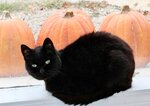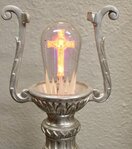



"Death's in the good-bye." - Anne Sexton
That quote by the Pulitzer Prize winning poet could easily be applied to the purpose of a unique museum that just opened in Thayer, dedicated to the traditions and rituals surrounding those good-byes and a poignant tribute to what may be the most common fear humans share — that of dying.
The Sixkiller Funeral Museum opened Oct. 14, just in time for spooky season.
Laila and Chris Sixkiller moved to Thayer from Springfield, and brought with them a collection of antique mortuary and funeral equipment. They have had an interest in funeral items for a while now, including six hearses which they hope to put on display in the garage that used to house ambulances when it was occupied by the Oregon County Ambulance dispatch, the most recent previous tenants, having vacated it in about 2008.
The hearses range in vintages from 1957 to 1996, and the couple is certainly qualified for their restoration and upkeep.
Chris works for Bell's Body Shop in West Plains and Laila is self-employed doing auto upholstery, and they are friends with Tony Huston, also of Thayer, who has his own hearses. They are members of the mid-states chapter of the Coffin Carriers hearse club and enter their vehicles in car shows.
They dream of adding a haunted house attraction on the third floor of their home, and they live on the second floor of the building. They even have a pet black cat who sleeps in an infant-sized coffin.
The museum’s curated collection includes items mostly from the 1930s through 1940s, but there are some from the 1970s. On exhibit are full-size caskets and sample displays, autopsy and embalming tools and equipment, mortuary makeup, and funeral parlor furniture and decor.
"It was a collection that almost turned into a hoard," Chris Sixkiller commented.
Some of the equipment is portable, for the purpose of use in services held in the deceased's home, a practice more common in the past.
Other items were intended to advertise mortuary products and burial items. There is a miniature model, for example, showing the features of a vault that is used to line a grave. It looks like almost like a large metal bread box with a removable lid suspended on a platform, attached to chains and pulleys over a larger box filled with water.
Chris described how vault salesmen would place a lit candle into it, put the lid on, lower the smaller box into the larger box, and then into the replica vault.
When the model was raised back up, the candle would still be burning, demonstrating the vault was sealed and waterproof, he explained.
Another funeral-related item showcased an engraved printing plate with a bottle-shaped cutout, designed to advertise different brands of embalming fluid. The bottle portion of the plate would be changed out to represent different brands.
Smaller items are located in display cases, one of them being a box of "thumb screws," but not the type that would come to most people's minds. In this case, the thumb screws aren't for torture, but to tighten the lids of coffins, and got their name because they were designed to be able to be tightened by hand.
Another collection of items of interest consists of decorative light bulbs set in elaborately decorated floor lamps. The bulbs have a crucifix in them that glows in neon orange when turned on. They came with different designs, depending on the deceased’s religion, Chris commented.
Such bulbs can still be found online through specialty lighting shops, with crucifixes and the Star of David.
Chris pointed out the museum likes to highlight some of the first female morticians in the business, much more uncommon about 100 years ago.
An autopsy table on display is believed to have been used for the post-mortem examination of the “Birdman of Alcatraz,” Robert Stroud, who spent the last few years of his life at the Medical Center for Federal Prisoners in Springfield. Stroud died there Nov. 21, 1963.
The table was donated to the Sixkillers’ museum by the Gorman-Scharpf Funeral Home in Springfield. Other display objects have been donated by funeral homes that have closed.
The outside of the building is hard to miss, and is decorated with a huge skeleton and a display of faux tombstones to set the mood for what's inside at 203 Front St. Admission is free by appointment on the weekends, but the couple accepts donations. Call 417-840-4054 to make an appointment, or join their Facebook group, “Sixkiller Funeral Museum.”